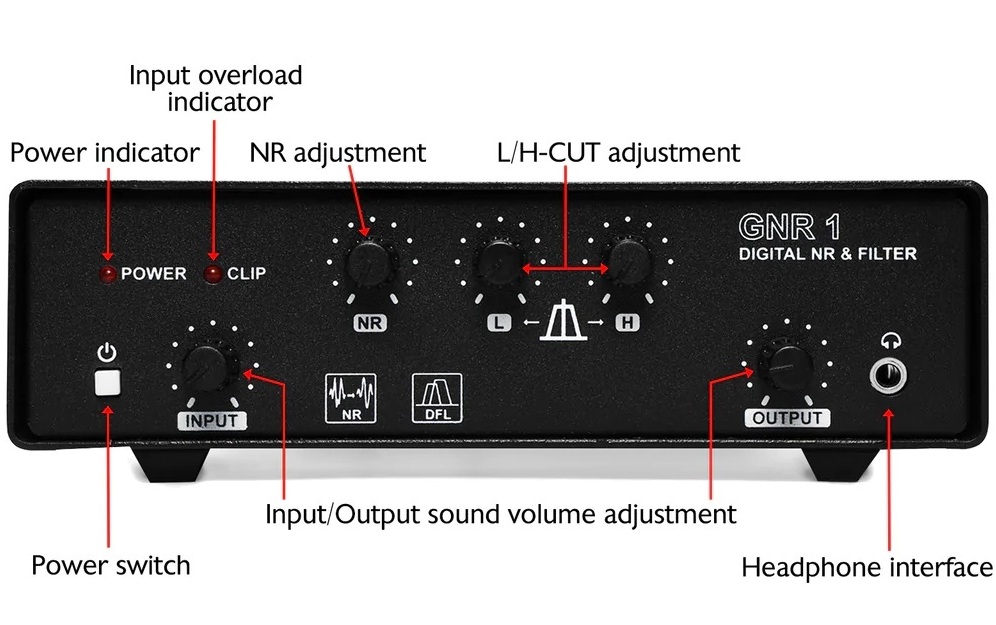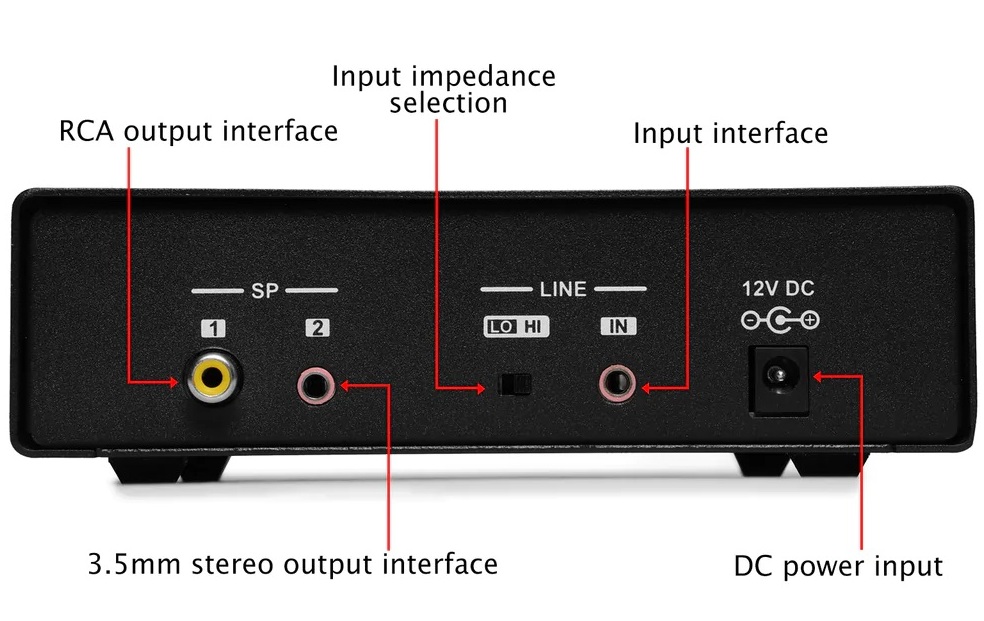By Jock Elliott, KB2GOM
Call me a retro-crank, an old-schooler, but part of the joy of listening to shortwave is that the signals sound like they have come from far away. There is nothing like hearing the music, the news, the commentary “filtered through the shortwaves” . . . as Edward R. Murrow once put it.
At the same time, I am a content DXer (thanks David Goren for that phrase; it fits perfectly what I do). Merely hearing some scratchy, barely audible signal won’t scratch the itch; I want to hear what is being broadcast clearly enough to make sense of it.
And when something particularly catches my ear, there are times when I would like to minimize the noise.
That’s where the Xiegu GNR1 Digital Audio Noise Filter comes in. According to the Radioddity website (they loaned me the unit for testing) — https://www.radioddity.com – “The Xiegu GNR1 digital audio noise filter is an audio processing device integrating digital noise reduction and digital filtering. It can be widely used in the external audio processing sector of all types of wireless receiving equipment such as radio transceiver, receiver, radio, to effectively reduce the background noise, improve the signal-to-noise ratio, and improve the signal identifiable degree.”
What I found is a mixed bag. I had some difficulty getting the unit to work at first when I plugged my headphones into the headphones jack on the front panel. Once I plugged the phones into the SP #2 jack on the rear panel, I found the GNR1 will, indeed, reduce the noise on a relatively “fat” shortwave broadcast signal, rolling off the static with no digital artifacts and making the signal more pleasant for long-term listening. And you can use the high cut filter and low cut filter to tailor the sound to suit your ears, and they work quite well for that purpose.
On weaker signals, however, the GNR1 did not provide as much help in reducing noise or sometimes could not hear the signal at all.
For example, at my location east of Troy, NY, I can hear the Canadian time station CHU on 3330 nearly all the time. Today I could hear the time “pips” but down in the noise. I plugged in the BHI Compact In-Line Noise Eliminating Module (which I reviewed elsewhere), and I could hear the time station better, along the with the trickling water sound that is an artifact of the BHI noise reduction algorithm. But with the GNR1, it was as if the CHU time station had disappeared, no matter what adjustments I made to the device.
Bottom line, I can provisionally recommend the GNR1for reducing noise with no artifacts and tailoring audio on strong shortwave broadcast signals, but not for weak signals.



Jock,I didn’t realize that you authored the article on the Xiegu GNR-1,sorry,my overlooking the fact.I was interested in the Xiegu unit although I do have the BHI dual unit DSP in line module.There is a very well done video on its use by Mr.Waters,I believe on Youtube.So you actually have both units at this time.I read that you found the BHI unit a little better on weaker signals.The GNR has an extra adjustment,the L/H-cut adjustment,what does that actually do ? Since you have both the BHI & Xiegu units could you do a comprehensive comparison test of the two.No one Has done that yet, anywhere.Your”Compact” BHI is very similar to the dual Bhi that I have,If you have the time.Call it a shoot-out or face-off but it sure would be an interesting read.Thanks or possibly send it to my email,Thanks Again
Jack,
The BHI does a much better job with weak signals, but introduces that “trickling water” sound the more noise reduction is applied. The Xiegu unit works well on strong signals and introduces no artifacts. As the L/H-cut controls, they simply reduce the high or low frequencies and can be adjusted to act as a kind of “audio passband filter.”
I’ll think about doing a shoot-out, but I am not sure that it would add anything beyond what I just told you.
For what I do — tuning around and listening to utilities and the ham bands — the BHI unit is much better. For a dedicated program listener who wants to reduce noise on, say music programs, without artifacts, the Xiegu might be a better choice, but in my experience with the unit I tested, it works well only on strong signals.
Cheers, Jock
I have the Bhi in-line (dual) noise reduction unit.Reduction is the key word.It works like a charm with any voice communication,not music.I use it with a very quiet dipole.Disregarding theory,I have used it enough to know how effective it is,at least with my usual set-up in the woods,once you learn the adjustments.The unit really filters out atmospherics and static without affecting voice ,it adjusted properly.I would like to see the results of a shoot-out between the BHI unit and the new Xiegu GNR-1 one.Both are from England and it seems the GNR-1 has a few more fine tuning adjustments within it and is a little less costly,however the BHI unit can be purchased in the states with free shipping from DX Engineering.I only wish that units like these were around during the “golden times”of shortwave listening,say the 60’s, and on till the last two decades,sort of
Heathkit had a DSP audio filter kit which was really good. I built it and have it somewhere in storage.
I agree with grayhat that the audio output side is not the best place for DSP but from the standpoint of easy use with many radios, this approach is a lot more flexible.
The worst place to reduce. noise, is along the audio chain, where the RF already went through. all the RF stages; if you want to KILL noise, you’ll need to go up the. chain, starting from the amtenna, anything else is just a candy; sure, it may improve things sometimes, but if you want to deal with noise, then that isn’t the way to go
then, I’m probably just an old fart
Andrew, how would you go about filtering noise from an antenna?
As I wrote, working along the full chain, that is, starting with an antenna which by design helps reducing noise, like a loop or something like this
http://www.kk5jy.net/LoG/
proceed with a good low loss feedline and ensure to choke it to minimize common mode (and having the feedline acting as part of the antenna), then insert a noise phaser like the so-called “x-phase qrm eliminator”
https://www.g8jnj.net/rfnoisecancellation.htm
those will act on a SINGLE “type” of noise, so one may consider using (or building btw) two or three units, connected in series between them, but sharing the “noise” antenna; the audio filtering is really the last spot, and filtering there should just be a way to remove the last bits of noise which weren’t removed at RF; as for audio filtering, a simple, cheap, yet effective one is described here
http://www.qrp.gr/tmaf/
sure, it doesn’t use DSP or such, but it’s pretty effective in reducing/removing undesired signals and/or noise
I agree with using a noise phaser. Noise is enemy #1 here and the device helps noticeably. But it also reminds me that I should get out the old YouLoop and pinpoint my noise sources more accurately in order to get the most out of the noise phaser. Maybe I can try to document it if I have time.
The RF choke at the receiver input also helps some.
Andrew,
It would probably be worth doing a series of articles/posts on how to kill noise “going up the chain.”
Cheers, Jock
If you’re looking into trying to eliminate noise I would highly suggest you investigate antenna phasing for the purpose of noise cancellation. Some very noticeable gains can be made there.
It’s not the noise that’s the problem with “content DX”, it’s the fact that almost no one broadcasts to N. America in English anymore (preacher creatures being the exception). We don’t need another noise reducer, we need a desktop translator. Wouldn’t that be great ? !
Don,
You’re right; a real-time desktop translator would be pretty slick.
Cheers, Jock
I followed the software setup in these series of articles for language translation. There are several posts on the translation experiments. I found this most interesting so I tried it with my SDR.
http://play.fallows.ca/wp/radio/shortwave-radio/swbc-translation-experiments/#more-10291
Works reasonably well with my RSPdx. Not 100% accurate but well enough to follow along with the conversation. I would guess you could use an audio cable to an Android phone for receivers.